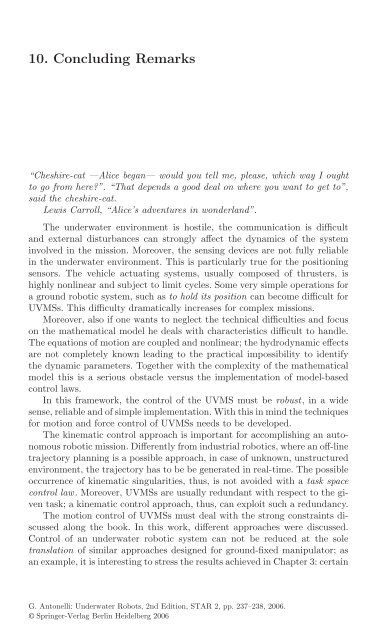Underwater Robots - Gianluca Antonelli.pdf
Underwater Robots - Gianluca Antonelli.pdf
Underwater Robots - Gianluca Antonelli.pdf
Create successful ePaper yourself
Turn your PDF publications into a flip-book with our unique Google optimized e-Paper software.
10. Concluding Remarks<br />
“Cheshire-cat —Alice began— would you tell me, please, which way Iought<br />
to go from here?”. “That depends agood deal on where you want to get to”,<br />
said the cheshire-cat.<br />
Lewis Carroll, “Alice’s adventures in wonderland”.<br />
The underwater environment ishostile, the communication is difficult<br />
and external disturbances can strongly affect the dynamics of the system<br />
involved in the mission. Moreover, the sensing devices are not fully reliable<br />
in the underwater environment. This is particularly true for the positioning<br />
sensors. The vehicle actuating systems, usually composed of thrusters, is<br />
highly nonlinear and subject tolimit cycles. Some very simple operations for<br />
aground robotic system, such as to hold its position can become difficult for<br />
UVMSs. This difficulty dramatically increases for complex missions.<br />
Moreover, also ifone wants toneglect the technical difficulties and focus<br />
on the mathematical model he deals with characteristics difficult tohandle.<br />
The equations of motion are coupled and nonlinear; the hydrodynamic effects<br />
are not completely known leading to the practical impossibility toidentify<br />
the dynamic parameters. Together with the complexity ofthe mathematical<br />
model this is aserious obstacle versus the implementation of model-based<br />
control laws.<br />
In this framework, the control of the UVMS must be robust ,inawide<br />
sense, reliable and of simple implementation. With this in mind the techniques<br />
for motion and force control ofUVMSs needs to be developed.<br />
The kinematic control approach is important for accomplishing anautonomous<br />
robotic mission. Differently from industrial robotics, whereanoff-line<br />
trajectory planning is apossible approach, in case of unknown, unstructured<br />
environment, the trajectory has tobebegenerated in real-time. The possible<br />
occurrence of kinematic singularities, thus, is not avoided with a task space<br />
control law. Moreover, UVMSs are usually redundant with respect to the given<br />
task; akinematic control approach, thus, can exploit such aredundancy.<br />
The motion control of UVMSs must deal with the strong constraints discussed<br />
along the book. In this work, different approaches were discussed.<br />
Control ofanunderwater robotic system can not be reduced at the sole<br />
translation of similar approaches designed for ground-fixed manipulator; as<br />
an example,itisinterestingtostress the results achieved in Chapter 3: certain<br />
G. <strong>Antonelli</strong>: <strong>Underwater</strong> <strong>Robots</strong>, 2nd Edition, STAR 2, pp. 237–238, 2006.<br />
© Springer-Verlag Berlin Heidelberg 2006






